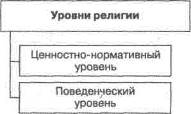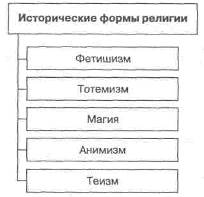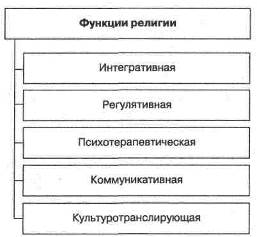Lecture

Scheme 13.1. Religion definition
Chapter 13. The Sociology of Religion
Religion is one of the oldest social institutions. It appeared before science, family, state, social protection institutions. The first religious systems arose from the need to explain the unknown, astonishing and fearful natural phenomena. In the future, in the process of developing scientific knowledge, the function of explaining the unknown comes to them more and more, and religion functions such social functions as consolidating society, strengthening power and management systems, strengthening social control, providing social protection, social support and psychological relief.
The separating approach. Representatives of this approach proceed from the fundamental differences between the belief system and society. For them, religion is initially transcendental (that is, otherworldly), non-social and agnostic, and society is “posistoronets” and is quite recognizable. Only some of the components of religion are social - religious organizations, institutions, and communities. Proponents of this approach give appropriate definitions of religion. For example, the Protestant theologian and sociologist R. Otto (1869-1937) believed that religion is an experience of the saint, and its subject should be considered numiose, that is, the will that comes from the deity, power, power that causes pious fear and awe in a person and at the same time charm and animation.
The connecting approach. Its representatives do not build an insurmountable barrier between religion and society, but consider the study of religion, along with other social structures, to be quite normal. For example, the German theologian, culturologist and sociologist E. Trelch (1865-1923) raised the question of the impact on religion of economic, political, family and other social relations.
Sociological approach. Its representatives emphasize social relations linking belief systems and human communities, the social functions performed by religions in various societies, the place, role and social status of the church in society, its relations with other social institutions, primarily the state . Modern American sociologist G. Lensky defined religion as "a system of beliefs about the essence of the forces that ultimately govern the fate of man, and the associated rituals performed by members of a particular group." As we see, in Lensky religion is understood as one of the factors influencing a person along with other social factors.
Chapter 13. The Sociology of Religion

Scheme 13.2. Religion structure
Chapter 13, Sociology of Religion
1. Groups of believers are communities of Catholics, Protestants, Judaists, Orthodox, Muslims, Buddhists, etc., as well as sects (Pentecostals, shakers, whips, etc.).
2. Sacred concepts, sacraments - phenomena associated with supernatural forces (miracles, prohibitions, covenants, communion).
3. Religion - a set of beliefs that explain the structure of the world, human nature, the surrounding nature, supernatural powers.
4. Rituals - the totality of certain actions, patterns of behavior in relation to the sacred and supernatural forces.
5. Representations of a righteous way of life - a system of moral principles, standards of life that govern people's behavior. For example, the ten commandments of Christianity, the rules of Sharia in Islam.

Scheme 13.3. Two levels of religion
A complex set of beliefs, symbols, values, moral commandments is contained in sacred texts. These sacred texts are for believers a source of knowledge about the world, nature, space, man and society. Knowledge is closely intertwined with an artistic-figurative or fantastic image of earthly and heavenly life. Religious ideas have a strong impact on the feelings and emotions of believers, forming in them a special, religious perception of the world. Religious beliefs and knowledge are special value systems based not so much on the mind as on faith, on a special religious feeling. In addition, they include traditional moral values and norms of human civilization. Therefore, religion, as a rule, contributes to the integration and stabilization of society.
The behavioral level of religion. Religious behavior differs sharply from behavior in other areas of human activity, primarily the predominance of emotional-affective experiences. Therefore, religious action refers to the type of affective, illogical, irrational social action, largely associated with the unconscious sphere of the human psyche. The central place in religious activity belongs to worship, the content of which is determined by religious norms and values.

Scheme 13.4. Historical forms of religion
Fetishism. Fetish (lat. - magic) - an item that struck the imagination of believers (an unusual stone, animal’s tooth, jewelry), endowed with mystical, supernatural properties, such as healing, protection from enemies, and hunting assistance. Not only religious, but also practical, everyday relationships are associated with a fetish of people: they thank a fetish for helping, for punishing it, they punish or replace it with another.
Totemism is a belief in the existence of a kinship between a group of people (clan, tribe) and a particular plant or animal. The term "totem" came from the language of the Ojibwe Indians and means "its kind." Indians considered totems as those species of plants and animals that gave them the opportunity to exist and survive in difficult conditions. At the initial stage of the development of totemism, sacred plants or animals were eaten. Then elements of social, blood-kinship relations were introduced into totemism - members of the clan (tribe) believed that their ancestors had some features of the totem. Strengthening the cult of ancestors led to the ban (taboo) on eating totem, with the exception of special rituals.
Magic is a set of representations and ceremonies based on the belief in the possibility of influencing people, objects and phenomena through certain actions. Magical ideas arise when a person is not confident in his abilities, when the solution to problems depends not so much on him, but on other factors. This makes him rely on the help of mysterious forces.
Animism is a belief in the existence of souls and spirits. This implies faith in the transmigration of souls, the spiritualization of natural phenomena.
Theism is a belief in gods or in a single god. Such gods are thought of as human-like (anthropomorphic) and endowed with their own names. The hierarchy of gods usually corresponds to the organization of human society. Faith in many gods is called polytheism and arises before monotheism - faith in one god. Monotheism in human society arose in the process of the formation of Judaism (the turn of the 1st — 2nd millennium BC) and the three so-called world religions: Buddhism (VI and V centuries BC), Christianity (I century AD ) and Islam (VII c).
Sociologists and anthropologists still do not have a consensus on the historical dates of the emergence and existence of certain religious forms. A proven trend can be considered the development of forms of religion from polytheism to monotheism and from anthropomorphic images of God (s) to an abstract idea of it. At least all modern world and largest regional and national religions are monotheistic.

Scheme 13.5. Religion Classification
According to the prevalence of religion can be divided into: worldwide (world), regional and national religions (Figure 13.5). Currently, there are three world religions: Christianity, which has three main branches (Catholicism, Orthodoxy, Protestantism), Islam, which consists of two streams (Sunnism and Shiism), and Buddhism: Tantrism (Indian Buddhism), Lamaism (Tibetan Buddhism), Chan Buddhism (Chinese Buddhism), Zen Buddhism (Japanese). Regional refers to religions that are common in several, usually neighboring, countries. For example, Hinduism takes place in India and Nepal, Confucianism in China, Korea, Japan, Taoism in China and Japan. We can also distinguish diaspora religions, which should be understood as a system of beliefs characteristic of the diaspora, i.e., an ethnically dispersed ethnic group that has not lost its identity and historical memory. Diaspora religions include, for example, Jewish, Christian-Gregorian (Armenian church) and some others. National religions include those that belong to one nation and, as a rule, are confined to national borders.
Geographically , Western religions are distinguished, which include all religions of ancient societies - Egypt, Mesopotamia, Greece, Rome, Slavs, as well as Judaism, Christianity and Islam. Religions of the East include Iranian, Indian, Chinese (Far Eastern) beliefs. The peripheral religions include the religions of African, Siberian, Native American (American Indians) and religions of the Pacific tribes.
| Religion | The number of believers | Countries of greatest distribution | |
| WORLD RELIGIONS | |||
| Buddhism | About 700 million | Vietnam, Kampuchea, Laos, Thailand, Sri Lanka. India, China, Japan. Russia (Buryatia, Kalmykia, Tuva) | |
| Christianity including: | More than 1 billion | * | |
| Catholics | More than 600 million | Spain, Portugal, France, Poland, Croatia and other European countries. USA, Latin American, African and Asian countries | |
| Orthodox | Over 200 million | Greece, Bulgaria, Romania, Russia, Ukraine, Belarus, Cyprus, Moldova, etc. | |
| Protestants | More than 350 million | Great Britain, Germany, Holland. Denmark, Sweden, Norway, Finland, Estonia, Latvia, USA | |
| Islam including: | About 800 million | Countries of the Arab East, Iran, Pakistan, North Africa, Turkey, Azerbaijan, countries of Central Asia. Bosnia and Herzegovina, Russia (North Caucasus, Tatarstan, Bashkortostan) | |
| Sunnis | About 90% | ||
| Shiites | About 10% | ||
| REGIONAL AND NATIONAL RELIGIONS | |||
| Hinduism | Less than 700 million | India, Nepal | |
| Jainism | - | India (Bihar) | |
| Sikhism | About 14 million | India (Punjab) | |
| Parsism | About 130 thousand | India, Iran | |
| Confucianism | - | China, Korea, Japan | |
| Taoism | - | China | |
| Shintoism | More than 80 million | Japan | |
| Judaism | About 20 million | Israel |
Scheme 13.6. World and national religions
| Criterion | Church | Denomination | Sect | Cult |
| Membership Source | All or most members of society | Recruiting community members, sometimes new people, by faith | Brotherhood of faithful believers; persuasion | Brotherhood of faithful believers; emotional crisis |
| Relation to the state and other religions | Closely connected with the state and non-religious organizations | In normal relations with the state, but is not included in its structure, and a weaker connection with non-religious organizations | Opposes other religions, as well as state and secular authorities | Denial of other religions, as well as state and secular authorities |
| Type of manual | Full-time professional priests | Professional priests | Unprofessional leaders with poor training | Charismatic Leaders |
| Type of creed | Formal theology | Tolerance of various points of view and disputes | Emphasis on the purity of teaching and a return to the original principles | New principles; revelation and penetration into the spiritual essence |
| Member engagement | Minimized or not at all required for rank and file members | Insignificant involvement, other duties are allowed | Need a deep sense of devotion | Full dedication needed |
| Type of religious action | The presence of rituals, liturgies | The presence of rituals, weak emotional expressiveness | Global emotionality encouraged by involuntary religious expression | Deep emotionality |
| Example | Roman Catholicism. Anglican Church. Russian Orthodox Church | Methodism. Con gregationalism | Jehovah witnesses. Christian science | Aum Senrikyo (Japan), Unification Church (Munnits). White Brotherhood (Ukraine, Russia) |
Scheme 13.7. Types of Religious Organizations
In this case, the church is understood as a religious organization having a rather large number of members in many social strata or in the majority of society, strong, long-term and ramified connections with this society.
Denomination is a typical American phenomenon, for it is placed in conditions of competition with churches, other denominations for parishioners. Denominations grew out of small religious communities, such as sects, and managed to spread their influence in society, but have not yet reached the size or influence of churches.
If the denomination coexists quietly in society, grows at the expense of new members and expands its influence, then a sect is such a religious organization that rejects some (but not all) of the principles of the dogma of the church, struggles with it, and closes itself into its problems. It is characterized by a small number, but a true devotion to the members.
A cult is also a small religious association, which is characterized by closeness to society, opposition from the dominant church, totalitarianism of inner life, specificity of rituals and unbridled enthusiasm for them. The most dangerous are the so-called totalitarian cults (sects), which require the complete devotion of members, establish community of property, prohibition of leaving the organization, the obligatory fulfillment of any, even the most absurd, requirements of its head.

Scheme 13.8. Types of believers
I
A theologically convinced believer has religious knowledge, is able to prove and defend his religious principles.
An emotional believer displays his religious feelings, but cannot always rationally explain them.
A ritual believer is inclined to perform religious rites, but he does not feel any real religious feelings.
The imaginary believer is trying to convince others of his faith, which is actually not.
The imaginary atheist does not participate in rituals, but deep down retains faith in supernatural powers, in miracles, etc.

Scheme 13.9. Religion functions
Integrative function. It allows you to unite people into a single society, stabilize it and maintain a certain social order.
Regulatory function. It consists in the fact that religion strengthens and strengthens the norms of behavior accepted in society, exercises social control, both formal (through church organizations) and informal (through believers themselves as carriers of moral norms). This function is also carried out through mechanisms and means of socialization.
Psychotherapeutic function. It consists in the fact that religious actions, services, rituals, rituals have a soothing, comforting effect on believers, give them moral firmness, confidence, protect them from stress and suicide.
Communicative function. Communication for believers unfolds in two ways: firstly, communication with God, celestials (the highest type of communication), and secondly, communication with each other (secondary communication). As a result of communication, a complex set of religious feelings arises: joy, tenderness, delight, admiration, submission, obedience, hope for a positive solution to problems, which creates a positive attitude, forms a motivation for further religious communication and church attendance.
Cultural transmitting function. It allows you to preserve and transmit cultural values and norms, cultural and scientific ideas about the world and man, historical traditions, memorable dates that have both a societal and a universal character.
Thus, despite its venerable age, religion in modern society continues to remain a fully functional social institution and plays an important integrating, regulatory, communicative, psychotherapeutic, and cultural-transmitting role.

Scheme 13.10. Perspectives of religion
Secularization is the process of crowding out the religious picture of the world with its scientific and rational explanation, it is the process of reducing the influence of religion on society and people’s activities, these are measures to separate the state, other social institutions from the church, and to reduce the control zone of the church in society.
Modernization manifests itself in temple architecture, religious painting, sculpture and literature, changes in worship, in holding social events in the churches (of course, promoting the moral growth of people and expanding the circle of parishioners), more active participation of the church in social life, encouraging the church to develop music, art, sports, care for education, leisure of parishioners.
The desire for ecumenism is a craving for an ever deeper interfaith understanding and cooperation. The most active in this are the Protestant churches, which put forward a proposal for the complete unification of all Christian churches and in 1948 created a special body for this - the World Council of Churches. Currently, the Pope and the Catholic Church actively support the idea of cooperation with all Christian churches, including the Russian Orthodox Church.
The pluralization of religion is the emergence of many new denominations and cults competing with the "old" churches, giving each member of society the opportunity to make their choice.
The emergence of a new religious consciousness based on personal faith and experience, and most importantly, on personal choice.
The acquisition by religion of a new social form containing certain sets of religious and secular values, norms and patterns of behavior, and each person is free to choose the appropriate religious system.
Religion in Russia
Religion in Russia survived in the XX century. Hard times. From the actual state institute of imperial Russia, the church under the Bolsheviks - militant atheists turned into one of the most persecuted and humiliated organizations. After the communists left power in modern Russia, a religious renaissance began : old ones were rebuilt and new churches were built, religious communities were growing, and the total number of believers was growing. Interest in religious values and norms, rites, and the history of religions is growing. Despite the fact that under the Constitution the Russian Federation is
secular state, the influence of religious ideas on the spiritual life of society and the clergy objectively strengthens public policy.
At the same time, it should be recalled that the State Duma adopted the Law on Freedom of Conscience and Religious Organizations (1990), according to which every citizen has the right to profess any religion or to be an atheist.
In modern Russia, the Orthodox religion is clearly dominant, and as the organization representing it is the Russian Orthodox Church, which is targeted at approximately 85% of Russians (of course, atheists should be excluded from this number). Given this fact, Christmas according to the Orthodox calendar (January 7) is declared a national holiday in Russia. Other Christian denominations (Catholic, Protestant), as well as Judaism, have little influence, mainly in Moscow, St. Petersburg, large cities, in the Volga region (in places of compact residence of ethnic Germans).
Islam in Russia is practiced by approximately 15-20 million people (10-12% of the population), living mainly in the Volga region (Tatarstan, Bashkortostan) and the North Caucasus (Chechnya, Ingushetia, Kabardino-Balkaria, Karachay-Cherkessia, Dagestan). There are Muslim communities in Moscow, St. Petersburg, and large cities.
The third world religion - Buddhism - is common in the Altai Territory, the republics of Buryatia and Kalmykia. In some large cities, Buddhist temples operate.
Comments
To leave a comment
Sociology
Terms: Sociology